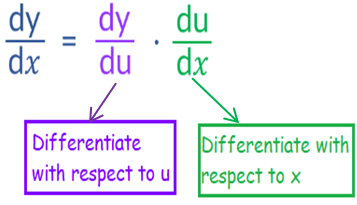USING CHAIN RULE TO FIND DERIVATIVE
Subscribe to our ▶️ YouTube channel 🔴 for the latest videos, updates, and tips.
In differential calculus, the chain rule is a formula used to find the derivative of a composite function.
If y = f(g(x)), then as per chain rule the instantaneous rate of change of function 'f' relative to 'g' and 'g' relative to x results in an instantaneous rate of change of 'f' with respect to 'x'.

Use the chain rule to find dy/dx at the indicated value of x.
Problem 1 :
y = 2u2 + 5 and u = 3x, when x = 1
Solution :
y = 2u2 + 5 and u = 3x
Here y is defined in terms of u and u is defined in terms of x.
|
dy/du = 2(2u) + 0 dy/du = 4u ----(1) |
du/dx = 3(1) du/dx = 3 ----(2) |
(1) ⋅ (2)
dy/dx = (dy/du) ⋅ (du/dx)
= 4u ⋅ 3
= 12 u
Here u = 3x
dy/dx = 12(3x)
dy/dx = 36x
dy/dx at x = 1 ==> 36(1) = 36
Problem 2 :
y = u2 - 5u and u = 2x + 1, when x = 0
Solution :
y = u2 - 5u and u = 2x + 1
Here y is defined in terms of u and u is defined in terms of x.
|
dy/du = 2u - 5(1) dy/du = 2u - 5 ----(1) |
du/dx = 2(1) + 0 du/dx = 2 ----(2) |
(1) ⋅ (2)
dy/dx = (dy/du) ⋅ (du/dx)
= (2u - 5) ⋅ 2
= 4u - 10
Here u = 2x - 1
dy/dx = 4(2x-1) - 10
= 8x - 4 - 10
= 8x - 14
dy/dx = 8x - 14
dy/dx at x = 0 ==> 8(0) - 14 ==> -14
Problem 3 :
y = 5/(u + 2) and u = 3x - 2, when x = 1
Solution :
y = 5/(u + 2) and u = 3x - 2
Here y is defined in terms of u and u is defined in terms of x.
y = 5(u + 2)-1
|
dy/du = -5(u + 2)-1-1 = -5/(u+2)2 ----(1) |
du/dx = 3(1) - 0 du/dx = 3 -----(2) |
(1) ⋅ (2)
dy/dx = (dy/du) ⋅ (du/dx)
= -5/(u+2)2 ⋅ 3
dy/dx = -15/(u + 2)2
Here u = 3x - 1
dy/dx = -15/(3x - 1 + 2)2
= -15/(3x + 1)2
When x = 1
dy/dx = -15/(3(1) + 1)2
dy/dx = -15/16
Problem 4 :
y = √(u2 + 3) and u = 2x2 - 1, when x = 1
Solution :
y = √(u2 + 3) and u = 2x2 - 1
Here y is defined in terms of u and u is defined in terms of x.
|
y = √(u2 + 3) dy/du = [1/2√(u2 + 3)] (2u) = u/√(u2 + 3) |
u = 2x2 - 1 du/dx = 2(2x) - 0 = 4x |
Problem 5 :
Solution :
Multiplying (1) and (2), we get
Subscribe to our ▶️ YouTube channel 🔴 for the latest videos, updates, and tips.
Recent Articles
-
Finding Range of Values Inequality Problems
May 21, 24 08:51 PM
Finding Range of Values Inequality Problems -
Solving Two Step Inequality Word Problems
May 21, 24 08:51 AM
Solving Two Step Inequality Word Problems -
Exponential Function Context and Data Modeling
May 20, 24 10:45 PM
Exponential Function Context and Data Modeling